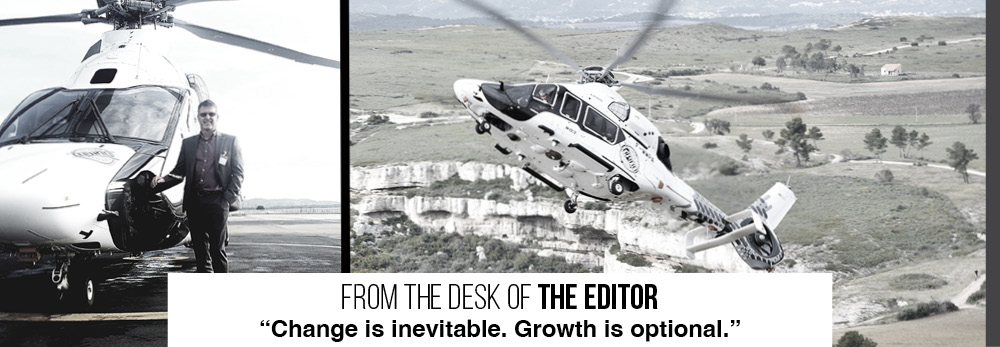|
Apr
25
2022
|
|
Posted 3 years 239 days ago ago by Admin
|
|

The title of this editor’s letter is actually a quote from John C. Maxwell, a No. 1 New York Times bestselling author, pastor, coach and speaker who has sold more than 24 million books in 50 languages. The quote reminds me that there is unprecedented change happening in every corner of our industry.
Carbon dioxide reduction, special aviation fuels, urban air mobility, e-vtol, personnel shortages, unmanned vertical flight, virtual-mixed reality in training, and the list goes on. The question for industry: Will this inevitable change be an opportunity for growth, or will many get left behind?
In February 2022, I was invited to Marignane, France, to visit the Airbus Helicopters manufacturing facility to not only fly in the H160, but also learn about Airbus Helicopters’ vision for the future. After two days of presentations, it was very clear that the manufacturer is making massive technology investments to develop data-driven customer service, revolutionize manufacturing, enhance operational safety, and define the future of vertical lift. To learn more, see the report of my visit titled, “Airbus Helicopters Issues in a New Age” on page 60.
In this issue's installment of Executive Watch, we spoke with Marek Polcak, CEO of Vrgineers. The company, pronounced V-R-gineers, are virtual reality (VR) engineers creating realistic training scenarios in virtual- and mixed-reality systems that put civilian and military helicopter pilots into certain scenarios that allow the training of more tactics or missions than a normal simulator. Vrgineers technology cannot only apply to flight training, but also to future maintenance. For example, if you want to learn maintenance for a Robinson R44, but don’t have the aircraft where you are, you will load an R44 training module into your VR headset and learn from that. If you are actually maintaining the aircraft, you would put on an augmented-reality headset that allows you to see through to the parts you are handling as the maintenance procedure outlines in your field of vision.
Finally, on page 46 we lay out the results of the Rotorcraft Pro 2021-2022 Annual U.S.Helicopter Pilot Salary and Benefits Survey. In this year’s report we reflect on key drivers that have led to the current pilot shortage, as well as how it’s impacting operator’s ability to attract and retain experienced helicopter pilots. In addition to reporting on helicopter pilot pay, benefits, and job satisfaction, we raise the alarm by asking the following questions: Can the helicopter industry in general compete with the airlines with respect to pay? If not, given the current supply situation, could the growth of the industry as a whole be stunted due to a shortage of helicopter pilots? If so, what can the industry actually do about it?
READ MORE ROTORCRAFT PRO
WATCH ROTORCRAFT PRO YOUTUBE CHANNEL
You can also find us on
Instagram - https://www.instagram.com/rotorcraftpro/
Facebook - https://www.facebook.com/rotorcraftpro/
Twitter - https://twitter.com/justhelicopters